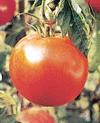- tomato
-
/teuh may"toh, -mah"-/, n., pl. tomatoes.1. any of several plants belonging to the genus Lycopersicon, of the nightshade family, native to Mexico and Central and South America, esp. the widely cultivated species L. lycopersicum, bearing a mildly acid, pulpy, usually red fruit eaten raw or cooked as a vegetable.2. the fruit itself.3. Older Slang (sometimes offensive). a girl or woman.[1595-1605; 1915-20 for def. 3; earlier tomate < Sp < Nahuatl tomatl]
* * *
Any fruit of the numerous cultivated varieties of Lycopersicon esculentum, a plant of the nightshade family.The plant is generally much branched and has hairy, strongly odorous, feathery leaves. The drooping, clustered, yellow flowers are followed by red, scarlet, or yellow fruits, which hang from the many branches of one weak stem. The tomato fruit varies in shape from spherical to elongate and in size from 0.6 in. (1.5 cm) across to more than 3 in. (7.5 cm) across. The Spanish were bringing tomatoes from South America to Europe by the early 16th century; they were introduced to North America from Europe by the 1780s. Tomatoes are used raw, cooked as a vegetable or puree, and pickled, canned, and sun-dried. The term also applies to the fruit of L. pimpinelli folium, the tiny currant tomato. Tomato (Lycopersicon esculentum).Grant Heilman
Tomato (Lycopersicon esculentum).Grant Heilman* * *
▪ fruitany fruit of the numerous cultivated varieties of Solanum lycopersicum (formerly Lycopersicon esculentum), a plant of the nightshade family (Solanaceae); also, the fruit of L. pimpinelli folium, the tiny currant tomato. Tomato plants are generally much branched, spreading 60–180 cm (24–72 inches) and recumbent when fruiting, but a few forms are compact and upright. Leaves are more or less hairy, strongly odorous, pinnately compound, and grow up to 45 cm long. The flowers are yellow, 2 cm across, pendant, and clustered. Fruits vary in diameter from 1.5 to 7.5 cm or more and are usually red, scarlet, or yellow; they vary in shape from almost spherical through oval and elongate to pear-shaped. The fruit is a soft, succulent berry, containing two to many cells of small seeds surrounded by jellylike pulp. Most of the tomato's vitamin C is found in this pulp. The tomato is used raw in salads, served as a cooked vegetable, used as an ingredient of various prepared dishes, and pickled.The wild species originated in the Andean area of South America, probably mainly in Peru and Ecuador, and is thought to have been domesticated in Mexico long before the arrival of Europeans; its name is derived from the Náhuatl (Aztec) word tomatl. The tomato was introduced to Europe by the Spanish in the early 16th century. The Spanish and Italians seem to have been the first peoples to adopt it as a food; it has remained a staple of Italian cuisine.The Italians called the tomato pomodoro (“golden apple”), which has given rise to speculation that the first tomatoes known to Europeans were yellow; similarly, it has been suggested that the French called it pomme d'amour (“love apple”) because it was thought to have aphrodisiacal properties. Some scholars assert, however, that the tomato was at first taken to be a kind of eggplant, of which it is a close relative. The eggplant was called pomme des Mours (“apple of the Moors”) because it was a favourite vegetable of the Arabs; pomodoro and pomme d'amour may be corruptions of this name.In France and northern Europe the tomato was at first grown as an ornamental plant. Since botanists recognized it as a relative of the poisons belladonna and deadly nightshade, it was regarded with suspicion as a food. (The roots and leaves of the tomato plant are in fact poisonous; they contain the neurotoxin solanine.)Tomatoes were introduced to North America from Europe; Thomas Jefferson is known to have raised them at Monticello in 1781. The tomato was used for food in Louisiana as early as 1812, but not in the northeastern states until about 1835, and it did not attain widespread popularity in the United States until the early 20th century.By the late 20th century the United States was the world's leading producer of tomatoes. Southern European countries, particularly Italy, are also major producers. Since the plant requires relatively warm weather and much sunlight, in northern Europe and Great Britain it is grown chiefly in hothouses. A large percentage of the world's tomato crop is used for processing; products include canned tomatoes, tomato juice, ketchup, puree, paste, and “sun-dried” tomatoes or dehydrated pulp.* * *
Universalium. 2010.
